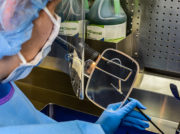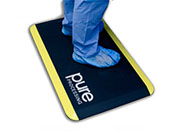
Solutions for the Top Ergonomic Issues in Reprocessing Departments
Following our previous blog post, How to Identify Ergonomic Concerns in Your Reprocessing Department, it’s time to discuss how to remedy some of these issues. Poor ergonomics can have a significant impact on employee safety, productivity, and overall job satisfaction. Fortunately, there are many solutions available that can alleviate these concerns and create a safer, more comfortable working environment. In this post, we will list the top five best remedies for ergonomic issues in the reprocessing department.
1. Sink Inserts
Many workplaces, like gastroenterology or sterile processing departments, recommended height-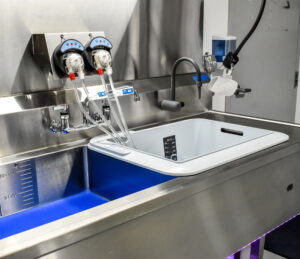 adjustable sinks to accommodate employees of different heights and reduce the risk of workplace injuries. However, the budget of many departments don’t often allow for immediate upgrades to height-adjusted sinks. In those cases, a more affordable and practical solution can be a is a sink insert. A sink insert is a temporary solution that can be easily installed into an existing sink basin to raise the work level, reducing the need for employees to bend over and potentially suffer from back injuries or strain.
adjustable sinks to accommodate employees of different heights and reduce the risk of workplace injuries. However, the budget of many departments don’t often allow for immediate upgrades to height-adjusted sinks. In those cases, a more affordable and practical solution can be a is a sink insert. A sink insert is a temporary solution that can be easily installed into an existing sink basin to raise the work level, reducing the need for employees to bend over and potentially suffer from back injuries or strain.
Sink inserts may also reduce water usage and are often made of a softer material, reducing impact damage for delicate devices.
2. Anti-Fatigue Mats
Anti-fatigue mats can help reduce the discomfort caused by periods of prolonged standing and working. Anti-fatigue mats are designed to provide a cushioned surface that can reduce foot, leg, and hip fatigue. Additionally, ANSI/AAMI ST91: 2021 4.2.1 suggests the use of anti-fatigue mats in areas where employees stand for extended periods, such as in front of decontamination sinks or prep and pack tables.
3. Automated Flushing Systems
Repetitive tasks requiring force and pressure, such as manual syringe flushing of lumened devices, can put a significant strain on the hands and wrists of technicians, potentially leading to injuries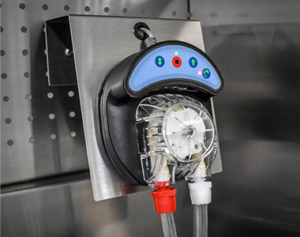 such as carpal tunnel syndrome and other musculoskeletal disorders. To address this risk, Independent Flushing Systems can be used.
such as carpal tunnel syndrome and other musculoskeletal disorders. To address this risk, Independent Flushing Systems can be used.
Automated flushing solutions allow for hands-free, ergonomic-friendly lumen flushing, removing the need for repetitive hand movements, and eliminating the risk of hand-related injuries and strain. Additionally, the use of an automated flushing system can help to address ergonomic concerns identified by HPSA and meet the standards set forth by ANSI/AAMI ST79:2017 and instructions for use (IFU) requirements.
4. Task Lights
In reprocessing departments, employees should pay close attention to detailed areas when inspecting 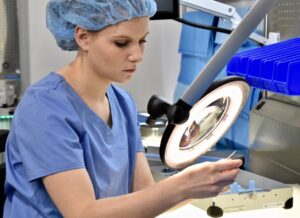 and cleaning instruments. This requires optimal lighting that illuminates the working area and provides a clear view of the instruments. Many sterile processing and gastroenterology departments struggle with optimal lighting, which has a direct impact on eye strain.
and cleaning instruments. This requires optimal lighting that illuminates the working area and provides a clear view of the instruments. Many sterile processing and gastroenterology departments struggle with optimal lighting, which has a direct impact on eye strain.
Task lights can provide the focused lighting necessary to make fine-detail inspection easier for nurses and technicians without added strain. Further, many task lights are equipped with a magnifier, enhancing one’s ability to visually inspect instruments. A magnifying lens can help nurses and technicians spot imperfections and defects that they may have missed with the naked eye, Reducing the likelihood of errors and defects.
5. Height Adjustable Sinks & Inserts
In any workplace, it’s common to have a team of employees of varying heights. This can create difficulties related to finding a work surface that is at the 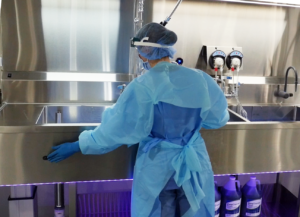 optimal height for each individual. However, with the use of height-adjustable sinks or tables, this problem can be easily solved. Height-adjustable sinks and tables are designed to allow the height of the surface to be adjusted at the push of a button, easily meeting the individual needs of nurses and technicians. This means that nurses and technicians can work at a height that is comfortable for them, ultimately reducing the risk of strenuous postures that can cause back, neck, and shoulder pain.
optimal height for each individual. However, with the use of height-adjustable sinks or tables, this problem can be easily solved. Height-adjustable sinks and tables are designed to allow the height of the surface to be adjusted at the push of a button, easily meeting the individual needs of nurses and technicians. This means that nurses and technicians can work at a height that is comfortable for them, ultimately reducing the risk of strenuous postures that can cause back, neck, and shoulder pain.
Height-adjustable equipment is suggested by OSHA as it can help to prevent work-related injuries and promote a safe, healthy working environment. By providing employees with the ability to work at an optimal height, employers can help to reduce the risk of musculoskeletal disorders and promote better overall employee health and well-being.
Conclusion
Addressing ergonomic concerns in reprocessing departments is essential for ensuring employee safety, productivity, and job satisfaction. By implementing solutions such as height-adjustable equipment, automated flushing systems, sink inserts, anti-fatigue mats, and adequate lighting, managers can help create a safer and more comfortable working environment for their team. It is important to regularly assess the ergonomic needs of the reprocessing department to ensure that solutions are effective and continue to meet the needs of the employees.
To see a full list of our ergonomic-focused products and solutions, click here.




